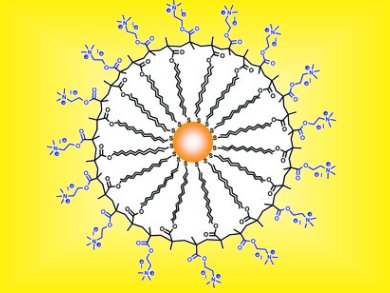Positively charged nanoparticles (NPs) are considered to be superior to anionic ones for several applications, for example, nanoprinting, which is typically performed on a slightly negatively charged paper. The common method of stabilizing NPs in aqueous solutions, which involves coating the NPs in amphiphilic polymers, has only led to anionic NPs.
Wolfgang Parakand co-workers, Philipps University Marburg, Germany, have synthesized a series of amphiphilic copolymers from positively charged N,N,N -trimethylammonium-2-ethyl methacrylate iodide or negatively charged 2-(methacryloyloxy)ethylphosphonic acid and lauryl methacrylate. Using these polymers, it was possible to reliably obtain positively and negatively charged NPs with high colloidal stability.
This method can be applied to NPs of different core materials and sizes, making it very versatile, and opens the way for investigation of charge-dependent processes, such as cellular uptake.
Image: © Wiley-VCH
- A General Synthetic Approach for Obtaining Cationic and Anionic Inorganic Nanoparticles via Encapsulation in Amphiphilic Copolymers
C. Geidel, S. Schmachtel, A. Riedinger, C. Pfeiffer, K. Müllen, M. Klapper, W. J. Parak,
Small 2011.
DOI: 10.1002/smll.201100509



